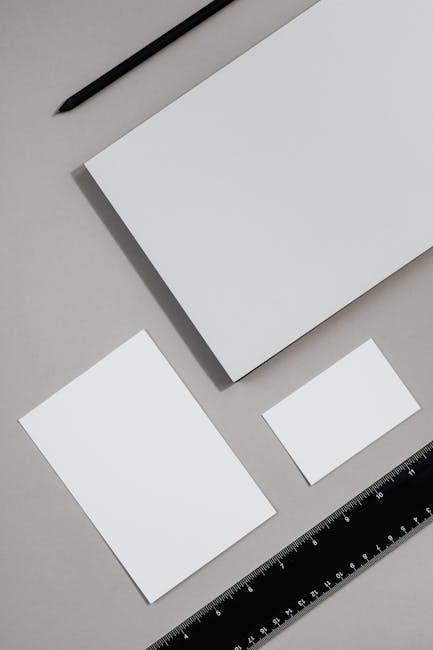The guide ruler is a tool used to draw straight lines and measure lengths, with various units of measurement, including inches and centimeters, marked on its edge for accurate readings always available online.
Definition of Ruler Guide
A ruler guide is a tool used to assist in drawing and measuring, it is typically a straight edge with markings to indicate units of measurement.
The definition of a ruler guide can vary depending on the context in which it is used, but generally, it refers to a device used to guide the drawing of straight lines or to measure the length of objects.
In the context of engineering and design, a ruler guide is often used to ensure accuracy and precision in drawings and measurements.
The ruler guide is an essential tool for anyone who needs to make precise measurements or drawings, and it is commonly used in a variety of fields, including architecture, engineering, and design.
The ruler guide is typically made of a rigid material, such as plastic or metal, and it has markings to indicate different units of measurement, such as inches or centimeters;
The ruler guide is a simple but essential tool that is used to guide the drawing of straight lines and to measure the length of objects, and it is an indispensable tool for anyone who needs to make precise measurements or drawings.
Importance of Ruler in Drawing
The ruler is a crucial tool in drawing, as it allows artists and designers to create straight lines and precise measurements.
In the drawing process, the ruler serves as a guide, enabling the creation of accurate and detailed designs.
The importance of a ruler in drawing lies in its ability to provide a straight edge, which is essential for creating precise lines and shapes.
Without a ruler, it would be difficult to achieve the level of precision and accuracy required in technical drawing and design.
The ruler also helps to speed up the drawing process, as it eliminates the need to freehand straight lines, which can be time-consuming and prone to errors.
By using a ruler, artists and designers can focus on the creative aspects of their work, rather than struggling to achieve precise lines and measurements.
Overall, the ruler is an essential tool in drawing, and its importance cannot be overstated, as it provides the foundation for creating accurate and detailed designs.

Uses of Ruler
Rulers are used for measuring and drawing purposes, including technical drawing and design, with various applications in engineering and architecture fields always.
Measuring Length and Width
Measuring length and width is a fundamental use of a guide ruler, allowing users to determine the size of objects with precision.
The ruler is placed alongside the object, with the zero point aligned with one end, and the length or width read off at the other end.
This process is essential in various fields, including engineering, architecture, and design, where accurate measurements are crucial.
The guide ruler’s markings, which include units of measurement such as inches or centimeters, enable users to take precise readings.
By using a guide ruler, individuals can ensure that their measurements are accurate and reliable, which is critical in many applications.
The ability to measure length and width accurately is a key benefit of using a guide ruler, making it an indispensable tool in many industries.
The guide ruler’s simplicity and ease of use make it an essential instrument for anyone who needs to measure objects with precision and accuracy.
Overall, the guide ruler is a vital tool for measuring length and width, and its importance cannot be overstated.
Drawing Straight Lines
Drawing straight lines is a primary function of a guide ruler, enabling users to create accurate and precise lines with ease.
The ruler’s edge serves as a guide, allowing users to draw along its length and create a straight line.
This is particularly useful in applications such as drawing, drafting, and design, where straight lines are essential.
The guide ruler’s straight edge ensures that the line is drawn accurately, without any deviations or irregularities.
By using a guide ruler, individuals can create straight lines with confidence, knowing that they will be precise and accurate.
The guide ruler’s ability to draw straight lines makes it an indispensable tool in many creative and technical fields.
It is also useful for marking dimensions and measurements on objects, making it a versatile and essential instrument.
The guide ruler’s simplicity and effectiveness in drawing straight lines have made it a staple in many industries and applications.
Overall, the guide ruler is a reliable tool for drawing straight lines, and its importance in various fields cannot be overstated.

Reading a Ruler
Understanding ruler markings and units is essential for accurate measurements and drawings always using guide ruler tools properly online every day.
Identifying Units of Measurement
To accurately read a ruler, it is crucial to identify the units of measurement marked on its edge. The most common units of measurement are inches and centimeters.
These units are usually marked with lines of varying lengths, with the shortest lines representing the smallest units of measurement.
By understanding the units of measurement, users can accurately measure lengths and widths of objects, and make precise drawings using the guide ruler.
The units of measurement are typically marked at regular intervals, allowing users to easily identify the measurements.
Additionally, some rulers may have additional units of measurement, such as millimeters or feet, which can be useful for specific applications.
Overall, identifying the units of measurement is an essential step in using a guide ruler effectively, and is a fundamental skill for anyone working with measurements and drawings.
By mastering this skill, users can ensure accuracy and precision in their work, and make the most of their guide ruler.
Locating the Zero Point
Locating the zero point on a guide ruler is a critical step in ensuring accurate measurements. The zero point is typically marked at the beginning of the ruler, and it serves as the reference point for all measurements.
To locate the zero point, users should look for a distinctive mark or line on the ruler that indicates the starting point of the measurements.
This mark is usually clearly labeled, and it may be accompanied by other markings or symbols that indicate the units of measurement.
Once the zero point has been located, users can begin measuring lengths and widths by aligning the object with the zero point and reading the measurement at the other end.
It is essential to ensure that the zero point is properly aligned with the object being measured to avoid errors.
By carefully locating the zero point and using it as a reference, users can make accurate and reliable measurements using their guide ruler.
This fundamental skill is essential for anyone working with guide rulers, and it is a crucial step in ensuring precision and accuracy in measurements and drawings.

Accuracy of Ruler

The guide ruler’s accuracy depends on the quality of its markings always being precise and clear for measurements to be reliable and consistent every time it is used online.
Limits of Ruler Accuracy
The limits of ruler accuracy are determined by the smallest unit of measurement marked on the ruler.
For example, if a ruler has markings for every millimeter, it can be used to measure lengths with an accuracy of plus or minus one millimeter.
The accuracy of a ruler is also affected by the quality of its construction, with high-quality rulers having more precise markings and being less prone to wear and tear.
In general, the limits of ruler accuracy will depend on the specific ruler being used and the task at hand.
Rulers with finer markings will be more accurate than those with coarser markings.
It is also important to note that the accuracy of a ruler can be affected by the user’s ability to read the markings correctly.
Overall, understanding the limits of ruler accuracy is important for ensuring that measurements are accurate and reliable.
This is particularly important in fields such as engineering and architecture, where small errors in measurement can have significant consequences.
Estimating Between Marks
Estimating between marks on a ruler is a crucial skill for achieving accurate measurements.
This involves using visual judgment to determine the position of a point or object between the marked graduations on the ruler.
To estimate between marks, it is essential to understand the scale of the ruler and the spacing between the markings.
For example, if the markings are 1 millimeter apart, it may be possible to estimate the position of a point to within 0.5 millimeters.
The ability to estimate between marks accurately depends on the quality of the ruler and the user’s level of experience and skill.
In general, it is easier to estimate between marks on a ruler with finer markings, as the graduations are closer together.
By practicing estimating between marks, users can improve their measurement skills and achieve more accurate results.
This skill is particularly useful when working with objects that have irregular shapes or sizes, where precise measurement is critical.
With experience, users can develop a high level of accuracy when estimating between marks on a ruler.
